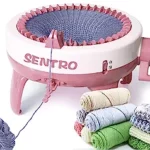Picture this: You excitedly embark on your first knitting project, armed with colorful yarn and brand-new needles. Full of enthusiasm, you start knitting, only to find yourself in a hilariously tangled mess. The yarn slips from your fingers, knots itself around the needles, and seems to have a mischievous mind of its own. Frustration sets in as you struggle to regain control, resulting in uneven stitches and a growing pile of yarn scraps.
In a moment of desperation, you turn to a seasoned knitter for help. With a mischievous grin, they show you the proper way to hold the yarn while knitting. Suddenly, it's like magic! The yarn glides effortlessly through your fingers, and your stitches become smooth and even. You can't help but laugh at the difference it makes. From that moment on, you vow to master the art of yarn holding and keep the yarn mischief at bay. As you become more adept, you can't help but chuckle at the memory of your yarn escapades, knowing that learning how to hold yarn was the key to knitting success—and avoiding becoming entangled in yarn chaos once and for all!
How to Hold Yarn When Knitting: Mastering Tension and Control for Flawless Stitches
The way you hold your yarn while knitting plays a significant role in the overall outcome of your project. Proper yarn tension and control are essential for creating even, consistent stitches and producing beautifully crafted items. As a knitter, finding the most comfortable and efficient method of holding yarn is crucial for an enjoyable knitting experience. In this comprehensive guide, we will explore various yarn holding techniques, their step-by-step instructions, and tips to help you find the perfect grip to enhance your knitting prowess.
The Importance of Proper Yarn Holding
Holding yarn correctly is a foundational knitting skill that impacts the look and feel of your knitting projects. Achieving consistent yarn tension ensures your stitches are uniform and helps prevent loose or tight sections in your work. Proper yarn holding also affects knitting speed, efficiency, and even hand comfort during extended knitting sessions. By mastering the art of yarn holding, you will gain control over your knitting and be well on your way to creating flawless stitches in all your projects.
Common Yarn Holding Techniques
There are several popular yarn holding techniques used by knitters around the world. Each method has its benefits, and the best one for you depends on personal preference and the desired knitting speed. Let's explore the three most common yarn holding techniques:
English (Throwing) Style
The English style, also known as throwing, involves holding the working yarn in your right hand.
Step-by-step instructions for the English style:
- Hand Position: Hold the knitting needle with your right hand like a pencil, resting the tip on your right thigh or under your right arm for stability.
- Wrap Yarn Around Fingers: Loop the working yarn over your right index finger, then bring it under your middle finger and over your ring finger. Let the yarn drape loosely over your right thumb.
- Tensioning the Yarn: Use your right index finger to control the tension of the yarn. Gently pinch or release the yarn to adjust tension as needed.
- Knitting: Insert the right needle into the stitch on the left needle, wrap the working yarn around the right needle from back to front, and pull the yarn through to create a new stitch.
Pros and cons of the English style:
The English style provides excellent control over the yarn, making it ideal for intricate stitch patterns and colorwork. However, some knitters find it slower than other techniques due to the extra motion of throwing the yarn over the needle.
Continental (Picking) Style
The Continental style, also known as picking, involves holding the working yarn in your left hand.
Step-by-step instructions for the Continental style:
- Hand Position: Hold the knitting needle with your left hand, resting the tip on your left thigh or under your left arm for stability.
- Wrap Yarn Around Fingers: Loop the working yarn over your left index finger, then bring it under your middle finger and over your ring finger. Let the yarn drape loosely over your left thumb.
- Tensioning the Yarn: Use your left index finger to control the tension of the yarn. Gently pinch or release the yarn to adjust tension as needed.
- Knitting: Insert the right needle into the stitch on the left needle, use your left index finger to "pick" the working yarn and draw it through the stitch to create a new stitch.
Pros and cons of the Continental style:
The Continental style is praised for its efficiency and speed, as there is less hand movement involved. It is particularly popular among crocheters transitioning to knitting. However, some knitters may find it challenging to maintain consistent tension with this technique.
Combination Style
The Combination style is a less common method that combines aspects of both English and Continental knitting.
Step-by-step instructions for the Combination style:
- Hand Position: Hold the knitting needle with your right hand like a pencil, resting the tip on your right thigh or under your right arm for stability.
- Wrap Yarn Around Fingers: Loop the working yarn over your left index finger, then bring it under your middle finger and over your ring finger. Let the yarn drape loosely over your left thumb.
- Tensioning the Yarn: Use your left index finger to control the tension of the yarn. Gently pinch or release the yarn to adjust tension as needed.
- Knitting: Insert the right needle into the stitch on the left needle, wrap the working yarn around the right needle from back to front, and use your left index finger to "pick" the yarn and draw it through the stitch to create a new stitch.
Pros and cons of the Combination style:
The Combination style provides the advantages of both English and Continental knitting, making it a versatile choice for knitters seeking a balance between speed and control. However, it may take some practice to get comfortable with this unique technique.
Choosing the Right Yarn Holding Technique
Choosing the right yarn holding technique is a matter of personal preference and comfort. Consider the following factors when deciding on a technique:
Comfort: Choose a method that feels comfortable and natural for your hands. Your knitting experience should be enjoyable and pain-free.
Efficiency: Some knitters find one technique faster than others due to the ease of movement and tension control.
Previous Experience: If you have experience with crochet, you may find the Continental style more familiar, as it shares similarities with crochet techniques.
Project Requirements: Consider the type of project you're working on and the stitch patterns involved. Certain projects may be more manageable with specific yarn holding techniques.
Tips for Perfecting Yarn Holding
Regardless of the yarn holding technique you choose, these tips will help you perfect your grip and improve your knitting experience:
- Relaxed Grip: Avoid clenching or gripping the yarn too tightly. A relaxed grip allows for smooth yarn movement and prevents hand fatigue.
- Tension Control: Practice controlling yarn tension with your index finger. Experiment with different tensions to find the one that creates even stitches.
- Consistency: Maintain a consistent tension throughout your knitting to ensure uniform stitches.
- Practice Regularly: Like any knitting skill, yarn holding improves with practice. Spend time knitting swatches to get comfortable with your chosen technique.
- Switching Techniques: Don't be afraid to experiment with different yarn holding techniques. You might find that a combination of styles works best for you.
Conclusion
Holding yarn correctly is a vital skill that every knitter should develop. Whether you prefer the English, Continental, or Combination style, finding the right yarn holding technique will empower you to create flawless stitches and enjoy the art of knitting to the fullest. Experiment, practice, and most importantly, have fun as you discover the yarn holding method that brings your knitting projects to life! Happy knitting!
To find out more about knitting, please visit any of the following areas:
- How to sew together knitting
- What is brioche knitting
- How to join yarn in knitting
- How to join in the round knitting
- How to finish a knitting scarf
- How to make a slip knot for knitting
- How to switch colors knitting
- How to hold yarn when knitting
- What does kfb mean in knitting
- How to fix a dropped stitch in knitting
- How to hold knitting needles
- What is frogging in knitting?
- How to change colors in knitting
- How to count rows in knitting
- How to increase in knitting
- How to slip stitch knitting
- How to yarn over in knitting
- What is a knitting loom?
- How to make bobbles in knitting?
- Where can I buy sentro knitting machine?
- What can you make with a sentro knitting machine?
- Cricut Hat Press: A Comprehensive Guide on Usage - August 13, 2023
- Unlocking Creativity with the Cricut Joy: A Comprehensive Guide - August 12, 2023
- The Ultimate Guide to the Cricut Maker Bundle - August 11, 2023





